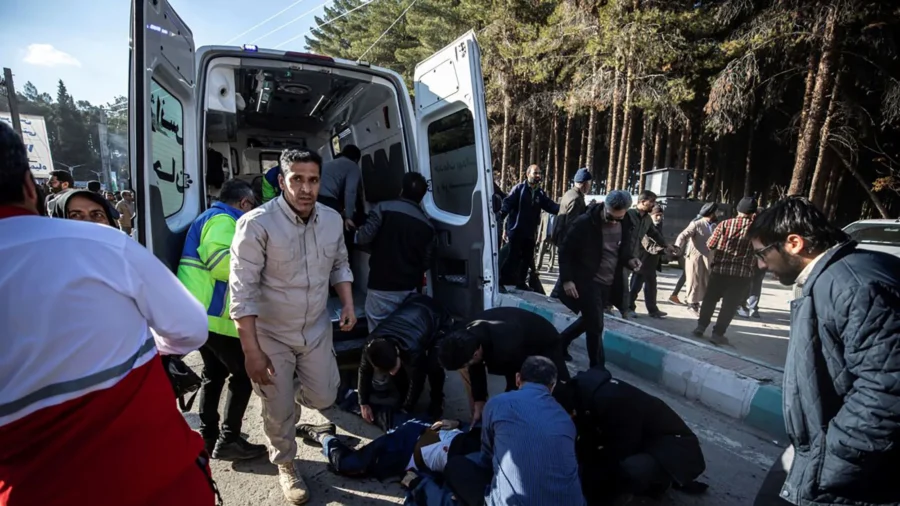A memorial in Iran commemorating the fourth anniversary of the death of the Islamic Revolutionary Guard Corps Quds Force (IRGC-QF) commander Qassem Soleimani was rocked by a pair of explosions that killed dozens of people.
Iranian Health Minister Bahram Eynollahi told state television the death toll now stands at 95, a downward revision after Iranian state-run media outlets reported as many as 103 people were killed in a pair of blasts on Wednesday. Mr. Eynollahi said up to 211 others were injured in the explosions, which occurred near the tomb of the deceased general in the southeastern Iranian city of Kerman on Wednesday.
The Iranian state-run Islamic Republic News Agency (IRNA) reported at least two blasts occurred near the memorial event, with the first going off about 700 meters (765 yards) from the commander’s tomb and the second going off around a kilometer away from the tomb.
Kerman’s deputy governor for security Rahman Jalali subsequently assessed that the blasts were the result of a terrorist attack.
The second explosion reportedly occurred about 20 minutes after the first. Terrorist organizations have been known to detonate a secondary explosive several minutes after an initial attack, maximizing casualties as emergency responders arrive at the scene.
No group immediately claimed responsibility for the Wednesday explosions in Kerman. The Iranian government has also provided few additional details about who they believe is responsible for them.
Iran has previously been targeted by terrorist attacks launched by the ISIS terrorist group, including a combined suicide bombing and mass shooting attack in the capital city of Tehran on June 7, 2017. That attack saw one group of terrorists open fire at an Iranian parliamentary building while a second group of terrorists opened fire at the Mausoleum of Ruhollah Khomeini before detonating suicide bombs at both locations, killing at least 17 people and wounding dozens more.
ISIS claimed responsibility for another attack in the southwestern Iranian city of Shiraz on Oct. 26, 2022. The incident saw a lone gunman enter the Shah Cheragh mosque, a popular Shia pilgrimage site, before opening fire with a rifle, killing at least 13 and wounding dozens more.
The Iranian government has also battled with dissident Shia factions such as the People’s Mojahedin Organization of Iran (also known as Mojahedin-e-Khalq or MEK).
The Israeli government has been suspected of carrying out sabotage operations and targeted assassinations in the past over Iran’s nuclear program, but it has not carried out mass casualty bombings. Iranian security chief Ali Shamkhani alleged the Israeli government and MEK members coordinated in the Nov. 27, 2020 assassination of an Iranian nuclear scientist. MEK denied the allegation.
In a Wednesday evening statement to the United Nations, Iranian Ambassador to the U.N. Amir Saeid Iravani said “Iran is committed to leveraging all available mechanisms to ensure accountability for those responsible and their accomplices in this heinous terrorist act.”
Blasts Come on Anniversary of the Soleimani Strike
The Wednesday blasts in Kerman came as crowds of Iranians gathered to memorialize Soleimani, who was killed in a U.S. airstrike ordered by then-President Donald Trump in Baghdad, Iraq on Jan. 3, 2020.
Soleimani was the head of the (IRGC) Quds Force, which specializes in terrorist operations outside of Iran, including providing for various Shia factions throughout the Middle East. The United States has designated the IRGC and many of its partner Shia factions as terrorist organizations.
Soleimani had arrived in Baghdad in 2020 just days after an attack on a U.S. airbase in Iraq that resulted in the death of a U.S. civilian contractor. The U.S. side had suspected members of Kata’ib Hezbollah were responsible for the attack. The Kata’ib Hezbollah is another U.S.-designated foreign terrorist organization.
Upon arriving in Baghdad on Jan. 3, 2020, Soleimani embarked on a motorcade alongside Abu Mahdi al-Muhandis, who was commander of the Kata’ib Hezbollah organization. Soleimani, al-Muhandis, and several other members of their security detail were killed by missiles fired from a U.S. MQ-9 Reaper drone.
Following the U.S. strike, the Iranian government responded by launching multiple ballistic missiles targeting U.S. forces in Iraq on Jan. 8, 2020. One hundred and ten U.S. personnel were wounded in the Iranian missile attack, including many traumatic brain injuries (TBIs), though no U.S. personnel were killed.
The Iranian government has repeatedly asserted its right to carry out additional retaliatory actions against the United States over the killing of Soleimani.
In August of 2022, the U.S. Department of Justice announced charges against a suspected IRGC member, alleging he worked to recruit people within the United States to kill President Trump’s former national security advisor, John Bolton, likely in retaliation for Soleimani’s death. The suspected IRGC member, Shahram Poursafi, remains at large.
The Iranian government has also called on the International Criminal Police Organization (INTERPOL) to issue an arrest warrant for President Trump over the January 2020 airstrike.
On Tuesday, the Iranian mission to the United Nations again insisted that the Iran government has a legitimate right under international law to pursue legal proceedings against those responsible for killing Soleimani.
Reuters contributed to this article.


